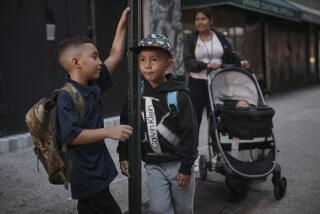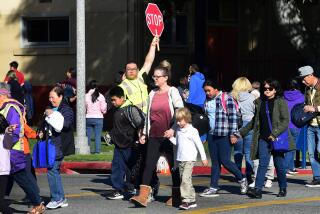The city where kids think on their feet
- Share via
You can’t daydream very long on a New York City subway or bus without noticing a boy in the seat across from you. He invariably looks 10 but is really 12 or maybe 13. Invariably, he has a big backpack balanced on his bony knees, a set of earphones around his neck, and a cellphone bulging from the pocket of his cargo pants. Clearly, he is somebody’s little boy on his way to or from school. You can’t help but wonder how he feels on his own.
Jesse, Steve, and Brendan, three such boys, piled into a booth at a pizza joint at 11:30 one morning last week. Lunch at their middle school “stinks” so they like to have lunch out in the neighborhood. These days the price of a slice ($1.95) is still a nickel cheaper than the new subway fare.
Which is a good thing because, intrepid New Yorkers that they are, Jesse, Steve, and Brendan always make sure they have enough money after lunch so there is something in their pocket for a mugger.
This sounds worse than it is. Only Jesse has had money snatched from his backpack. Still, all three boys, as they negotiate New York every day, live by a set of rules -- some set for them by their parents, others they have set for themselves.
“Get your slice and move down please,” the guy behind the counter shouts. A crowd of kids is descending on the small pizza shop at 97th Street and Madison Avenue, a few blocks from a competitive Manhattan public school that draws the brightest kids from every borough. This morning Jesse, Steve and Brendan, all eighth-graders, get to share an entire cheese pizza. A reporter is paying, and Brendan, to show his appreciation, offers Real Fact No. 137 from the cap of his Snapple strawberry-kiwi drink. It reads: “The City of Los Angeles has 3xs more automobiles than people.” This cracks them all up. Rich or poor, they explain, New York kids rely on public transportation and their feet.
“We have our subways, our buses and our streets,” says Jesse Soll, who has been venturing out alone in his neighborhood since he was 9, and commuting alone to school by bus and subway since he was 11. Now he is two weeks from his 13th birthday and he has mapped the city in his mind for where he can or shouldn’t go.
Every week and every new experience alters that map. And so after a taxi driver mistakenly dropped him at 125th Street in the heart of Harlem, a bustling area where few white kids travel alone, he has put all but a small section of that major thoroughfare off-limits. In the meantime, his mother, Cathy Soll, who has spent years teaching Jesse the language of New York pedestrians, closely monitors his path around the city. “My theory is that he’s a savvy kid and has a healthy respect for the potential dangers of New York,” she says.
Jesse and many of his friends have cell phones to keep in touch with their parents, but when Soll, who is 43, was growing up in Manhattan, she was lucky if she could get to a pay phone if there was trouble. Soll walked alone to elementary school in the 1960s when the crime rate was much worse than it is now, and foolishly walked between cars on a moving subway when she was Jesse’s age.
“I know how stupid kids can be so of course I worry,” she says. “But I have a lot of faith in Jesse.”
Many American parents probably can’t imagine allowing their 12-year-olds to travel alone in a big city. But not New Yorkers. The public transportation system and the ubiquity of sidewalks, hectic as they are, give adults a unique mobility, which they offer to their kids, sons and daughters alike. Each parent determines a child’s readiness for independence. But, says Stoll, it comes eventually to all: “There were kids who were taking the train alone in the fifth grade and I thought of the mother, ‘She’s nuts!’ But every kid is ready for what they do when they do it.”
Some parents are more protective than others, and some private schools insist students stay on campus all day. For example, while Jesse’s and Steve White’s parents gave them cellphones in sixth grade and let them ride subways alone, the parents of Brendan Feng, who has an hour commute to school from Queens, must always ride with a friend. Brendan doesn’t have a cellphone, nor is he supposed to leave campus for lunch (unless invited by a reporter). Born in China, Feng came to New York with his parents at age 4 and says they’re still not entirely comfortable in the city.
Cathy Soll began Jesse’s street education when he was very young. She’d tell him you have to wait for the “Walk” sign at a light before you cross, but more important, you have to watch the traffic because drivers don’t always respect the light. She’d talk to him about homeless people and what to do if a bigger kid hassled him. Always ask a mother with kids for help, she counseled. She’ll rescue you.
It’s understood that kids get mugged, beaten, snatched and caught in a cross-fire all to often. Still, New York also understands that kids are capable of having their freedom, within limits. (It’s essentially a city where neighborhoods operate like small towns, and there is usually someone friendly around.) The public schools hand out free subway and bus passes; the Safe Haven program supplies hand-shaped stickers for the windows of stores that welcome kids who need help; and taxi drivers all over the city have been known to give a kid a free ride if a mugger is chasing him.
This happened to Jesse once. Bouncing a basketball, he was on his way home from school through Central Park one beautiful day last fall when “some guy” demanded money. “I didn’t have any at the time and tried to give him my basketball but he wouldn’t take it,” says Jesse, who has innocent green eyes and is just barely 5 feet. “I ran and jumped in a taxi and the guy was nice enough to take me across the park for free.”
He’s had other near misses and so has Steve, who is six inches taller than Jesse.
These run-ins have left the boys with prejudices, but not the ones you would think. “White, black or Hispanic is all the same,” said Steve, who lives in an apartment across from ground zero in Battery Park City. “It’s how a person acts or what he’s wearing or if he’s with a gang of friends that scares me.”
All the boys describe times in their travels when they wished their parents were with them. Like after Steve broke his wrist in a soccer game and felt defenseless on the subways because he was wearing a cast.
Or the time Jesse was skateboarding alone in Central Park and broke his elbow.
He sat on the ground for 15 minutes and finally picked himself up, walked over to a restaurant and called his mom. She didn’t freak out, says Jesse, finishing his third slice.
In a country where the carpool is king, you can’t help but wonder what parents are thinking when they let the tether out far enough to leave a little boy on his own in New York City.
Steve, Jesse and Brendan are late for class. But before they leave, they explain that they all have relatives who don’t live here and think it’s weird that they’re growing up in New York, taking their skateboards to the park, listening to preachers on the subway, stopping on their way home to watch break dancers on the sidewalk. “I guess it’s more fun to go to a mall,” says Jesse, slyly. They all crack up.
More to Read
Sign up for The Wild
We’ll help you find the best places to hike, bike and run, as well as the perfect silent spots for meditation and yoga.
You may occasionally receive promotional content from the Los Angeles Times.






